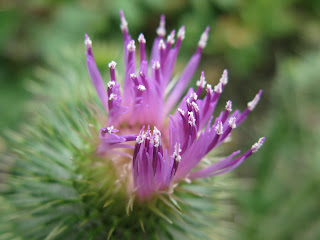

From berry to cider, the process became much more than making something to drink.
A special batch of manzanita berry cider was made for the Chuck Haugen Conservation Fund annual picnic. Berry picking was a community affair on Friday, September 11 with eight people (I'm taking the picture) spending half a day out on beautiful Fort Ord public lands collecting.

Some of us went back to Marina and spent a few more hours sorting through to clean the berries. What a relief because it would've taken me five times as long to do it myself and it would never have been as much fun. Since all the berries were clean, I could spend Saturday making cider. Note - it's called cider but is simply juice from the berry. Simple. Refreshing.
I put the clean berries, one cup at a time, in my little cuisinart to grind.

Small bits of yerba buena were in the mix and the aroma of the crushed berries with a little of the herb was sweet and light.

The dry berries are powdery and at this time of year the berries still on the plant, if you can find them, are perfect for the cider. The ground berries were mixed with water and left to sit. I tried cold water and hot. The berries mixed with cold water sat for 9-12 hours in the refrigerator and yielded a liquid much more clear than the hot. The hot water treatment included boiling the water and pouring it over the crushed berries, letting it sit for one hour before straining. The hot water cider was darker.
The taste of each was distinct. The cold water cider was light, tart, and sweet. The hot water cider was a bit more mellow without the bite, with a taste that wasn't bitter but darker or "more woody" as Eric Van Dyke put it. Most people, myself included, preferred the cold water cider. I did sweeten a hot water batch with agave nectar. This was a good addition but one I would not make with cold water cider.
OK. Enough about the cider. Let's get to how we use our wild lands. This process of collecting, cleaning, grinding, and extracting the juice, throws me deep into thought about the modern use of wild places. The history of California has changed so much over the last 20,000 years. Understatement, I know. But our management of the land has drastically changed throughout this time. Right now at the Elkhorn Slough for example, we don't harvest wild plants and animals for food and materials for household use. Why? Different goals. Would people even be interested in this type of use? California Department of Fish and Game owns the land that is the Reserve. Would they even allow such a different type of management strategy on this land? Could I connect with a local community to even brainstorm ideas on a more sort of indigenous management regime?
It's been the rule that whoever owns or occupies the land makes the decisions about what is to be done with that land. Plants and animals have to adapt to that - whatever land use is currently being employed. Or they die or move out and others move in. People, the general public, may or may not know what's going on and may or may not care. We don't need to get into modern land use policy and public participation here. But I do want to explore this subject - go a bit further and expand our ideas of management - think creatively about our goals.











